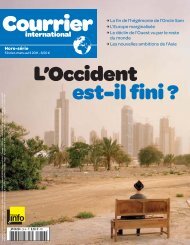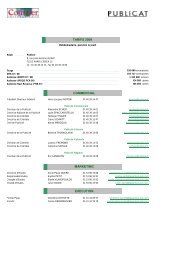2 ОРГАНИЗАЦИЯ И МЕТОДИКА РАБОТ - Courrier international
2 ОРГАНИЗАЦИЯ И МЕТОДИКА РАБОТ - Courrier international
2 ОРГАНИЗАЦИЯ И МЕТОДИКА РАБОТ - Courrier international
Create successful ePaper yourself
Turn your PDF publications into a flip-book with our unique Google optimized e-Paper software.
Module of deactivation of liquid waste<br />
Module of deactivation of liquid waste (MNO) can be used in conjunction with module<br />
extraction and neutralization of waste drums or as a standalone technology node for the<br />
elimination of only hazardous waste.<br />
The principle of operation of the module is based on the implementation of the technology of<br />
thermal cracking reaction mass formed in the receiving capacity of the module extraction and<br />
neutralization of waste drums.<br />
The main unit of the module is to install high-temperature oxidation, carrying out the thermal<br />
cracking of PCB-containing wastes.<br />
High-temperature oxidation is conducted in a specially designed furnace [64, 65]. The choice of<br />
temperature, time of thermal treatment is carried out according to the analysis.<br />
This technology is based on a set of systems of high-temperature oxidation (node thermal<br />
expansion) and neutralization of waste gases.<br />
Module neutralization of liquid waste includes the following main parts:<br />
site transportation of liquid waste;<br />
thermal cracking unit;<br />
site preparation and dispensing of reagents;<br />
Automated control system for the INR, which includes remote control with built-in<br />
programmable electronic system;<br />
site cleaning of flue gases.<br />
Node transport liquid waste is a block with stop and control valves, pumps and flow meter,<br />
which allows to carry out manufacturing operations for transportation of the reaction mass from<br />
the module extraction waste site thermal cracking with the desired flow rate.<br />
When a reaction mixture from the receiving vessel operator via remote control command is<br />
given to the pump of liquid waste. Reaction mass through the pipeline enters the balancing<br />
reservoir, from which gravity is sent to the site of thermal cracking. Required flow rate of waste<br />
supplied to the combustion is controlled by the flowmeter.<br />
Thermal cracking unit of waste is from a rotary furnace and flue gas cleaning system, mounted in<br />
a single unit.<br />
The furnace design allows speed control and tilt tubes, purging the working chamber and the air<br />
temperature from 400 up to 1400 0C.<br />
Liquid waste enters the receiving device, on which is fed into a heating zone tube furnace and<br />
moves further along the pipe through the zone of combustion and pre-cooling. The resulting ash<br />
residue poured from the pipe end in the hopper, cool and collected in a soft container (rubber<br />
bag) for recycling.<br />
For the implementation of high-temperature oxidation through the tube current waste flow by<br />
forced air flow. Air is supplied through the suction port of the jet compressor, articulated with a<br />
tube furnace in the cooling zone. Selecting the mode of the furnace (the temperature in the<br />
reaction zone, the speed of the pipe, the angle of inclination, the volumetric flow rate of air<br />
oxidation) is performed by introducing a pre-programmed modes of operation by remote<br />
control.<br />
Kiln gases trapped gas flow jet compressor, partially cooled. The concentration of potential<br />
pollutants in the stream is reduced by dilution with compressed air. The cooled waste gas flow is<br />
FINAL REPORT for Contract No. CS-NPA-Arctic-13/2009 of December 01, 2009 within the framework of pilot project Development<br />
of Technology of clean up of the area of Decommissioned Sites of The Russian Federation Ministry of Defense in the Arctic by the<br />
Example of Alexanra Island of Franz Josef Land Archipelago from Hazardous Waste<br />
181<br />
181








